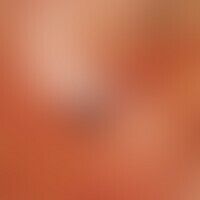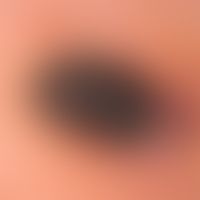Angiosarcoma of the head and face skin Images
Go to article Angiosarcoma of the head and face skin



Angiosarcoma of the head and facial skin: the 69-year-old patient noticed this rapidly growing and recurrently bleeding 3x5 cm large, little symptomatic node around the capillitium for 6 months. After incomplete preliminary surgery within a few weeks formation of the present recurrent node. The inconspicuous erythema around the node is noticeable. After the micrographically controlled surgery, the tumor was only free of tumor after an approximately 10 x 10 cm large excision.

Angiosarcoma of the head and facial skin: the 69-year-old patient noticed this rapidly growing and recurrently bleeding 3x5 cm large, little symptomatic node around the capillitium for 6 months. After incomplete preliminary surgery within a few weeks formation of the present recurrent node. The inconspicuous erythema around the node is noticeable. After the micrographically controlled surgery, the tumor was only free of tumor after an approximately 10 x 10 cm large excision.

Angiosarcoma of the head and facial skin: the 69-year-old patient noticed this rapidly growing and recurrently bleeding 3x5 cm large, little symptomatic node around the capillitium for 6 months. After incomplete preliminary surgery within a few weeks formation of the present recurrent node. The inconspicuous erythema around the node is noticeable. After the micrographically controlled surgery, the tumor was only free of tumor after an approximately 10 x 10 cm large excision.

Angiosarcoma of the head and facial skin. punch biopsy of black nodule in the patient described above. epidermis o.B., orthokeratosis, in the middle and deep corium convolute of densely packed, CD31 positive tumor cells. skin appendages largely intact (in the center longitudinally incised hair follicle). below the surface epithelium infiltrate-free zone; here numerous dilated (neoplastic?) vessels (clinical: telangiectasia).


Angiosarcoma of the head and facial skin (finding of the clinically presented solitary node): cluster of atypical, irregularly expanded, capillary-like structures partially filled with erythrocytes and lined by irregularly enlarged endothelia, which anastomose with each other. The endothelia show enlarged chromatin-rich nuclei and in places protrude button-like into the lumina. Isolated, they float solitary, also in groups in the lumina. In places the endothelial lining is completely missing. High proliferative activity demonstrable.